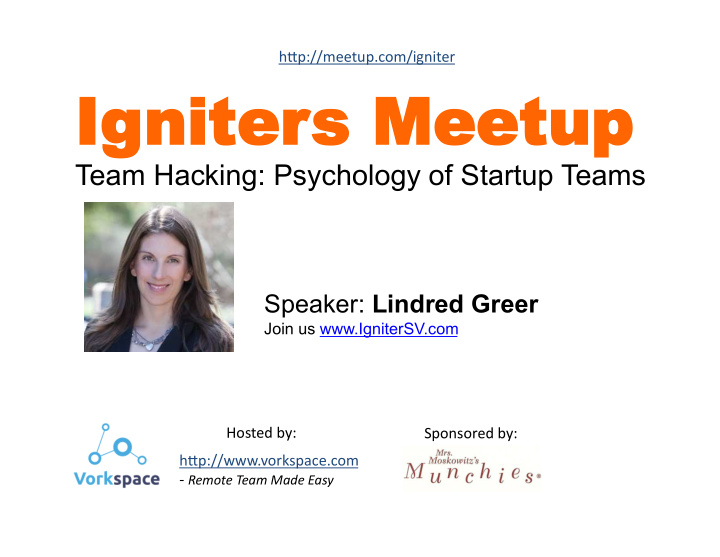



h0p://meetup.com/igniter Ignit gniter ers Meet eetup up Team Hacking: Psychology of Startup Teams Speaker: Lindred Greer Join us www.IgniterSV.com Hosted by: Sponsored by: h0p://www.vorkspace.com - Remote Team Made Easy
The Psychology of startup teams Professor Lindred Greer March 17, 2016
AGENDA FOR TODAY 01 02 03 INTRO � Interactive � Debrief and Discussion the Science Break-outs & � Exercise of Start-up Session Take- Team Aways Psychology
THE EXERCISE:
INSTRUCTIONS: � Build the Tallest Freestanding Structure: The winning team is the one that has the tallest structure measured from the table top surface to the top of the marshmallow. That means the structure cannot be suspended from a higher structure, like a chair, ceiling or chandelier. � The Entire Marshmallow Must be on Top: The entire marshmallow needs to be on the top of the structure. Cutting or eating part of the marshmallow disqualifies the team. � Use as Much or as Little of the Kit: The team can use as many or as few of the 20 spaghetti sticks, as much or as little of the string or tape. The team cannot use the paper bag as part of their structure. � Break up the Spaghetti, String or Tape: Teams are free to break the spaghetti, cut up the tape and string to create new structures. � The Challenge Lasts 15 minutes: Teams cannot hold on to the structure when the time runs out. Those touching or supporting the structure at the end of the exercise will be disqualified.
SCORES Team Height Time
The 3 Most Important Problems in Start-up Teams (and how to overcome them!)
THE 3 KEY CHALLENGES FOR START-UP TEAM EFFECTIVENESS � The Composition Problem + Is the right expertise available in the start- up team? � The Participation Problem High + Is the expertise being shared within the performance start-up team? group � The Influence Problem + Are individuals with expertise having as much impact as those with less expertise?
The Composition Problem – From Evolution
DOES THE START-UP TEAM HAVE Similar views? Disengagement? #$%@!!! A lack of disagreement? Images owned/created by Stanford Graduate School of Business, Barbara McCarthy
The Composition Problem � Actual Group Task � Members’ Perceived Performance - % Group Effectiveness Groups Accurate Socially � Socially Socially � Socially similar dissimilar similar dissimilar Phillips, K. W., Liljenquist, K.A., and Neale, M. A. (2009). Is the pain worth the gain? The advantages and liabilities of agreeing with socially distinct newcomers. Personality and Social Psychology Bulletin, 35, 336-350.
Solving the Composition Problem + Hire for task-relevant diversity + But ensure shared passion + Create ‘artificial diversity’ – embrace constructive controversy, devil’s advocacy, challenging assumptions, etc Image owned/created by Stanford Graduate School of Business, Barbara McCarthy
The Participation Problem “ 80/20 ” rule Image owned/created by Stanford Graduate School of Business, Barbara McCarthy
% Speaking Time in Meetings EVERYONE ELSE THE TEAM LEADER Image owned/created by Stanford Graduate School of Business, Barbara McCarthy
Hierarchy – From Evolution
Why It’s a Problem � We lose out on the unique value each person SHOULD bring to the team Image owned/created by Stanford Graduate School of Business, Barbara McCarthy
Equalizing Participation + Smaller size groups +Solicit data in advance of meetings + Build trust and psychological safety + Proximity and body language matter Image owned/created by Stanford Graduate School of Business, Barbara McCarthy
The Influence Problem � We ascribe people influence for qualities other than task competence
Influence – From Evolution
Bases for Influence Height Dominance Speaking Time Facial features Expertise Familiarity Attractiveness
Why It’s a Problem � Team Performance 0.6 0.5 0.4 0.3 0.2 0.1 0 Leader Selected on Other Leader Selected on Task Traits Knowledge Taracki, M., Greer, L.L., and Groenen, P. (2016). When does power disparity help or hurt group performance ? Journal of Applied Psychology , in press.
Align Expertise & Influence + Know who knows what + Ensure formal leaders are team players + Rotate meeting control Expertise Influence Image owned/created by Stanford Graduate School of Business, Barbara McCarthy
SUMMARY � What is most natural for the team is not necessarily what is best for the team when it comes to start-up performance + People often choose founders and early hires for reasons other than relevant skillsets + Team participation within the start-up is often dominated by a small minority of members + The people who often emerge as leaders are not necessarily the most qualified
GENERAL BEST PRACTICES FOR MANAGING START-UP TEAMS Please take the next 10 minutes to discuss in groups of 3 changes you can immediately make in the way you run your start-up
Key Take-away Tips Expertise Influence � Manage composition � Manage participation Manage influence + Use virtual chatrooms + Improve knowledge + Hire for task-relevant of members’ diversity + Solicit opinions in competences advance of meetings + But ensure shared + Ensure leaders are passion + Build trust and safety team players + Create ‘artificial + Use smaller groups + Rotate meeting diversity’ – embrace + Rely on evidence-based control based on constructive debate topic expertise controversy, devil’s + Ensure member visibility advocacy, challenging assumptions, etc
QUESTIONS? ?
THANK YOU! PLEASE FEEL FREE TO REACH OUT WITH ANY QUESTIONS lgreer@stanford.edu
h0p://meetup.com/igniter Ignit gniter ers Meet eetup up Team Hacking: Psychology of Startup Teams Speaker: Lindred Greer Join us www.IgniterSV.com Hosted by: Sponsored by: h0p://www.vorkspace.com - Remote Team Made Easy
Recommend
More recommend